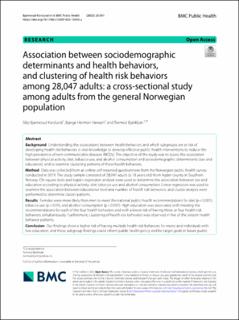| dc.contributor.author | Korslund, Silje Bjørnerud | |
| dc.contributor.author | Hansen, Bjørge Hermann | |
| dc.contributor.author | Bjørkkjær, Tormod | |
| dc.date.accessioned | 2024-02-06T12:24:21Z | |
| dc.date.available | 2024-02-06T12:24:21Z | |
| dc.date.created | 2023-03-22T18:55:04Z | |
| dc.date.issued | 2023 | |
| dc.identifier.citation | Korslund, S. B., Hansen, B. H. & Bjørkkjær, T. (2023). Association between sociodemographic determinants and health behaviors, and clustering of health risk behaviors among 28,047 adults : a cross-sectional study among adults from the general Norwegian population. BMC Public Health, 23: 541. | en_US |
| dc.identifier.issn | 1471-2458 | |
| dc.identifier.uri | https://hdl.handle.net/11250/3115914 | |
| dc.description.abstract | Background: Understanding the associations between health behaviors and which subgroups are at risk of developing health risk behaviors is vital knowledge to develop effective public health interventions to reduce the high prevalence of non-communicable diseases (NCDs). The objective of the study was to assess the association between physical activity, diet, tobacco use, and alcohol consumption and sociodemographic determinants (sex and education), and to examine clustering patterns of these health behaviors.
Method: Data was collected from an online self-reported questionnaire from the Norwegian public health survey conducted in 2019. The study sample consisted of 28,047 adults (≥18 years old) from Agder county in Southern Norway. Chi-square tests and logistic regression analysis were used to determine the association between sex and education according to physical activity, diet, tobacco use and alcohol consumption. Linear regression was used to examine the association between educational level and number of health risk behaviors, and cluster analysis were performed to determine cluster patterns.
Results: Females were more likely than men to meet the national public health recommendations for diet (p<0.001), tobacco use (p<0.01), and alcohol consumption (p<0.001). High education was associated with meeting the recommendations for each of the four health behaviors and with a lower risk of having three or four health risk behaviors simultaneously. Furthermore, clustering of health risk behaviors was observed in five of the sixteen health behavior patterns.
Conclusion: Our findings show a higher risk of having multiple health risk behaviors for males and individuals with low education, and these subgroup findings could inform public health policy and be target goals in future public | en_US |
| dc.language.iso | eng | en_US |
| dc.publisher | BioMed Central | en_US |
| dc.rights | Navngivelse 4.0 Internasjonal | * |
| dc.rights.uri | http://creativecommons.org/licenses/by/4.0/deed.no | * |
| dc.title | Association between sociodemographic determinants and health behaviors, and clustering of health risk behaviors among 28,047 adults : a cross-sectional study among adults from the general Norwegian population | en_US |
| dc.type | Journal article | en_US |
| dc.type | Peer reviewed | en_US |
| dc.description.version | publishedVersion | en_US |
| dc.rights.holder | © 2023 The Author(s) | en_US |
| dc.subject.nsi | VDP::Medisinske Fag: 700::Helsefag: 800::Samfunnsmedisin, sosialmedisin: 801 | en_US |
| dc.source.pagenumber | 8 | en_US |
| dc.source.volume | 23 | en_US |
| dc.source.journal | BMC Public Health | en_US |
| dc.identifier.doi | https://doi.org/10.1186/s12889-023-15435-y | |
| dc.identifier.cristin | 2136253 | |
| dc.relation.project | Universitetet i Agder: 689019 | en_US |
| dc.source.articlenumber | 541 | en_US |
| cristin.qualitycode | 1 | |

